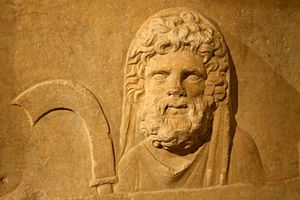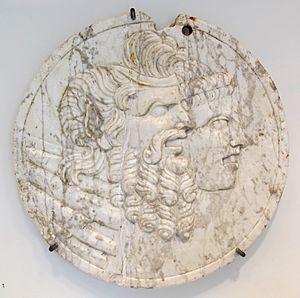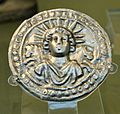Saturnalia facts for kids
Quick facts for kids Saturnalia |
|
|---|---|
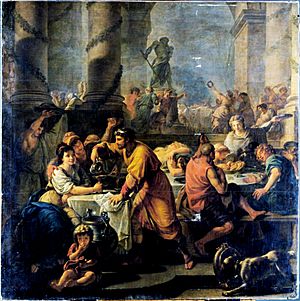
Saturnalia (1783) by Antoine-François Callet, showing his interpretation of what the Saturnalia might have looked like
|
|
| Observed by | Romans |
| Type | Classical Roman religion |
| Significance | Public festival |
| Celebrations | Feasting, role reversals, gift-giving, gambling |
| Observances | Public sacrifice and banquet for the god Saturn; universal wearing of the pileus |
| Date | 17–23 December |
Saturnalia is an ancient Roman festival and holiday in honour of the god Saturn, held on 17 December of the Julian calendar and later expanded with festivities through to 23 December. The holiday was celebrated with a sacrifice at the Temple of Saturn, in the Roman Forum, and a public banquet, followed by private gift-giving, continual partying, and a carnival atmosphere that overturned Roman social norms: gambling was permitted, and masters provided table service for their slaves as it was seen as a time of liberty for both slaves and freedmen alike. A common custom was the election of a "King of the Saturnalia", who gave orders to people, which were followed and presided over the merrymaking. The gifts exchanged were usually gag gifts or small figurines made of wax or pottery known as sigillaria. The poet Catullus called it "the best of days".
Saturnalia was the Roman equivalent to the earlier Greek holiday of Kronia, which was celebrated during the Attic month of Hekatombaion in late midsummer. It held theological importance for some Romans, who saw it as a restoration of the ancient Golden Age, when the world was ruled by Saturn. The Neoplatonist philosopher Porphyry interpreted the freedom associated with Saturnalia as symbolizing the "freeing of souls into immortality". Saturnalia may have influenced some of the customs associated with later celebrations in western Europe occurring in midwinter, particularly traditions associated with Christmas, the Feast of the Holy Innocents, and Epiphany. In particular, the historical western European Christmas custom of electing a "Lord of Misrule" may have its roots in Saturnalia celebrations.
Contents
Origins
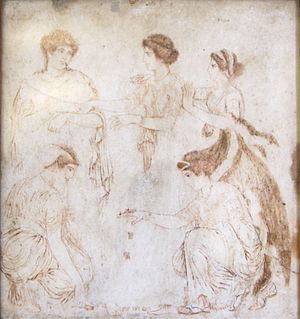
In Roman mythology, Saturn was an agricultural deity who was said to have reigned over the world in the Golden Age, when humans enjoyed the spontaneous bounty of the earth without labour in a state of innocence. The revelries of Saturnalia were supposed to reflect the conditions of the lost mythical age. The Greek equivalent was the Kronia, which was celebrated on the twelfth day of the month of Hekatombaion, which occurred from around mid-July to mid-August on the Attic calendar. The Greek writer Athenaeus also cites numerous other examples of similar festivals celebrated throughout the Greco-Roman world, including the Cretan festival of Hermaia in honor of Hermes, an unnamed festival from Troezen in honor of Poseidon, the Thessalian festival of Peloria in honor of Zeus Pelorios, and an unnamed festival from Babylon. He also mentions that the custom of masters dining with their slaves was associated with the Athenian festival of Anthesteria and the Spartan festival of Hyacinthia. The Argive festival of Hybristica, though not directly related to the Saturnalia, involved a similar reversal of roles in which women would dress as men and men would dress as women.
The ancient Roman historian Justinus credits Saturn with being a historical king of the pre-Roman inhabitants of Italy:
The first inhabitants of Italy were the Aborigines, whose king, Saturnus, is said to have been a man of such extraordinary justice, that no one was a slave in his reign, or had any private property, but all things were common to all, and undivided, as one estate for the use of every one; in memory of which way of life, it has been ordered that at the Saturnalia slaves should everywhere sit down with their masters at the entertainments, the rank of all being made equal."
—Justinus, Epitome of Pompeius Trogus 43.3
Although probably the best-known Roman holiday, Saturnalia as a whole is not described from beginning to end in any single ancient source. Modern understanding of the festival is pieced together from several accounts dealing with various aspects. The Saturnalia was the dramatic setting of the multivolume work of that name by Macrobius, a Latin writer from late antiquity who is the major source for information about the holiday. Macrobius describes the reign of Justinus' "king Saturn" as "a time of great happiness, both on account of the universal plenty that prevailed and because as yet there was no division into bond and free – as one may gather from the complete license enjoyed by slaves at the Saturnalia."
In one of the interpretations in Macrobius's work, Saturnalia is a festival of light leading to the winter solstice, with the abundant presence of candles symbolizing the quest for knowledge and truth. The renewal of light and the coming of the new year was celebrated in the later Roman Empire at the Dies Natalis Solis Invicti, the "Birthday of the Unconquerable Sun", on 25 December.
The popularity of Saturnalia continued into the 3rd and 4th centuries AD, and as the Roman Empire came under Christian rule, many of its customs were recast into or at least influenced the seasonal celebrations surrounding Christmas and the New Year.
Historical context
Saturnalia underwent a major reform in 217 BC, after the Battle of Lake Trasimene, when the Romans suffered one of their most crushing defeats by Carthage during the Second Punic War. Until that time, they had celebrated the holiday according to Roman custom (more Romano). It was after a consultation of the Sibylline Books that they adopted "Greek rite", introducing sacrifices carried out in the Greek manner, the public banquet, and the continual shouts of io Saturnalia that became characteristic of the celebration. Cato the Elder (234–149 BC) remembered a time before the so-called "Greek" elements had been added to the Roman Saturnalia.
It was not unusual for the Romans to offer cult (cultus) to the deities of other nations in the hope of redirecting their favour (see evocatio), and the Second Punic War in particular created pressures on Roman society that led to a number of religious innovations and reforms. Robert E.A. Palmer has argued that the introduction of new rites at this time was in part an effort to appease Ba'al Hammon, the Carthaginian god who was regarded as the counterpart of the Roman Saturn and Greek Cronus. The table service that masters offered their slaves thus would have extended to Carthaginian or African war captives.
Public religious observance
Rite at the temple of Saturn
The statue of Saturn at his main temple normally had its feet bound in wool, which was removed for the holiday as an act of liberation. The official rituals were carried out according to "Greek rite" (ritus graecus). The sacrifice was officiated by a priest, whose head was uncovered; in Roman rite, priests sacrificed capite velato, with head covered by a special fold of the toga. This procedure is usually explained by Saturn's assimilation with his Greek counterpart Cronus, since the Romans often adopted and reinterpreted Greek myths, iconography, and even religious practices for their own deities, but the uncovering of the priest's head may also be one of the Saturnalian reversals, the opposite of what was normal.
Following the sacrifice the Roman Senate arranged a lectisternium, a ritual of Greek origin that typically involved placing a deity's image on a sumptuous couch, as if he were present and actively participating in the festivities. A public banquet followed (convivium publicum).
The day was supposed to be a holiday from all forms of work. Schools were closed, and exercise regimens were suspended. Courts were not in session, so no justice was administered, and no declaration of war could be made. After the public rituals, observances continued at home. On 18 and 19 December, which were also holidays from public business, families conducted domestic rituals. They bathed early, and those with means sacrificed a suckling pig, a traditional offering to an earth deity.
Human offerings
Saturn also had a less benevolent aspect. One of his consorts was Lua, a goddess in whose honor the weapons of enemies killed in war were burned, perhaps in expiation. Saturn's chthonic nature connected him to the underworld and its ruler Dīs Pater, the Roman equivalent of Greek Plouton (Pluto in Latin) who was also a god of hidden wealth. In sources of the third century AD and later, Saturn is recorded as receiving dead gladiators as offerings (munera) during or near the Saturnalia. These gladiatorial events, ten days in all throughout December, were presented mainly by the quaestors and sponsored with funds from the treasury of Saturn.
Role reversal
Saturnalia was characterized by role reversals and behavioral license. Slaves were treated to a banquet of the kind usually enjoyed by their masters. Ancient sources differ on the circumstances: some suggest that master and slave dined together, while others indicate that the slaves feasted first, or that the masters actually served the food. The practice might have varied over time.
Saturnalian license also permitted slaves to disrespect their masters without the threat of a punishment. It was a time for free speech: the Augustan poet Horace calls it "December liberty". In two satires set during the Saturnalia, Horace has a slave offer sharp criticism to his master. Everyone knew, however, that the leveling of the social hierarchy was temporary and had limits; no social norms were ultimately threatened, because the holiday would end.
The toga, the characteristic garment of the male Roman citizen, was set aside in favor of the Greek synthesis, colourful "dinner clothes" otherwise considered in poor taste for daytime wear. Romans of citizen status normally went about bare-headed, but for the Saturnalia donned the pilleus, the conical felt cap that was the usual mark of a freedman. Slaves, who ordinarily were not entitled to wear the pilleus, wore it as well, so that everyone was "pilleated" without distinction.
The participation of freeborn Roman women is implied by sources that name gifts for women, but their presence at banquets may have depended on the custom of their time; from the late Republic onward, women mingled socially with men more freely than they had in earlier times.
Gift-giving
The Sigillaria on 19 December was a day of gift-giving. Because gifts of value would mark social status contrary to the spirit of the season, these were often the pottery or wax figurines called sigillaria made specially for the day, candles, or "gag gifts", of which Augustus was particularly fond. Children received toys as gifts. In his many poems about the Saturnalia, Martial names both expensive and quite cheap gifts, including writing tablets, dice, knucklebones, moneyboxes, combs, toothpicks, a hat, a hunting knife, an axe, various lamps, balls, perfumes, pipes, a pig, a sausage, a parrot, tables, cups, spoons, items of clothing, statues, masks, books, and pets. Gifts might be as costly as a slave or exotic animal, but Martial suggests that token gifts of low intrinsic value inversely measure the high quality of a friendship. Patrons or "bosses" might pass along a gratuity (sigillaricium) to their poorer clients or dependents to help them buy gifts. Some emperors were noted for their devoted observance of the Sigillaria.
In a practice that might be compared to modern greeting cards, verses sometimes accompanied the gifts. Martial has a collection of poems written as if to be attached to gifts. Catullus received a book of bad poems by "the worst poet of all time" as a joke from a friend.
Gift-giving was not confined to the day of the Sigillaria. In some households, guests and family members received gifts after the feast in which slaves had shared.
On the calendar
As an observance of state religion, Saturnalia was supposed to have been held "...quarto decimo Kalendarum Ianuariarum", on the fourteenth day before the Kalends of the pre-Julian, twenty-nine day December, on the oldest Roman religious calendar, which the Romans believed to have been established by the legendary founder Romulus and his successor Numa Pompilius. It was a dies festus, a legal holiday when no public business could be conducted. The day marked the dedication anniversary (dies natalis) of the Temple to Saturn in the Roman Forum in 497 BC. When Julius Caesar had the calendar reformed because it had fallen out of synchronization with the solar year, two days were added to the month, and the date of Saturnalia then changed, still falling on the 17 December, but with this now being the sixteenth day before the Kalends, as per the Roman reckoning of dates of this time. It was felt, thus, that the original day had thus been moved by two days, and so Saturnalia was celebrated under Augustus as a three-day official holiday encompassing both dates.
By the late Republic, the private festivities of Saturnalia had expanded to seven days, but during the Imperial period contracted variously to three to five days. Caligula extended official observances to five.
The date 17 December was the first day of the astrological sign Capricorn, the house of Saturn, the planet named for the god. Its proximity to the winter solstice (21 to 23 December on the Julian calendar) was endowed with various meanings by both ancient and modern scholars: for instance, the widespread use of wax candles (cerei, singular cereus) could refer to "the returning power of the sun's light after the solstice".
Influence
Unlike several Roman religious festivals which were particular to cult sites in the city, the prolonged seasonal celebration of Saturnalia at home could be held anywhere in the Empire. Saturnalia continued as a secular celebration long after it was removed from the official calendar.
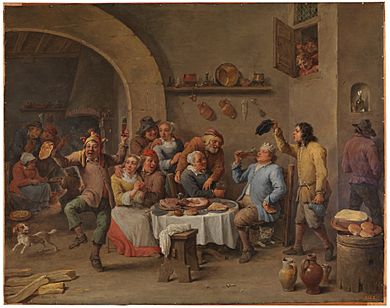
As a result of the close proximity of dates, many Christians in western Europe continued to celebrate traditional Saturnalia customs in association with Christmas and the surrounding holidays.
During the late medieval period and early Renaissance, many towns in England elected a "Lord of Misrule" at Christmas time to preside over the Feast of Fools. This custom was sometimes associated with the Twelfth Night or Epiphany. A common tradition in western Europe was to drop a bean, coin, or other small token into a cake or pudding; whoever found the object would become the "King (or Queen) of the Bean". During the Protestant Reformation, reformers sought to revise or even completely abolish such practices, which they regarded as "popish"; these efforts were largely successful. The Puritans banned the "Lord of Misrule" in England and the custom was largely forgotten shortly thereafter, though the bean in the pudding survived as a tradition of a small gift to the one finding a single almond hidden in the traditional Christmas porridge in Scandinavia.
Nonetheless, in the middle of the nineteenth century, some of the old ceremonies, such as gift-giving, were revived in English-speaking countries as part of a widespread "Christmas revival". During this revival, authors such as Charles Dickens sought to reform the "conscience of Christmas" and turn the formerly riotous holiday into a family-friendly occasion. Vestiges of the Saturnalia festivities may still be preserved in some of the traditions now associated with Christmas. The custom of gift-giving at Christmas time resembles the Roman tradition of giving sigillaria and the lighting of Advent candles resembles the Roman tradition of lighting torches and wax tapers. Likewise, Saturnalia and Christmas both share associations with eating, singing, and dancing.
Images for kids
-
Dice players in a wall painting from Pompeii
-
Saturn driving a four-horse chariot (quadriga) on the reverse of a denarius issued in 104 BC by the plebeian tribune Saturninus, with the head of the goddess Roma on the obverse: Saturninus was a popularist politician whose Saturnian imagery played on his name and evoked both his program of grain distribution to aid the poor and his intent to subvert the social hierarchy, all ideas associated with the Saturnalia.
-
Roman disc in silver depicting Sol Invictus (from Pessinus in Phrygia, 3rd century AD)
See also
 In Spanish: Saturnales para niños
In Spanish: Saturnales para niños


